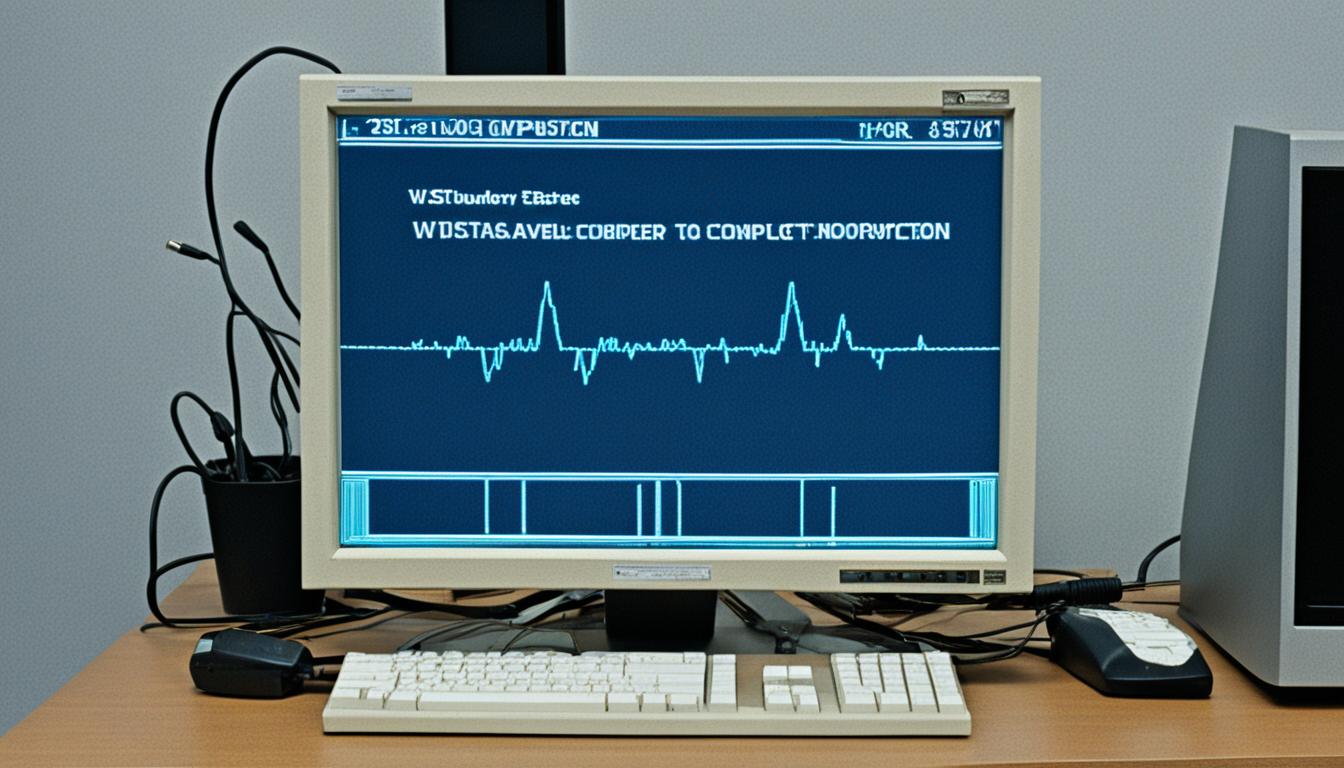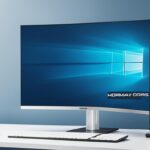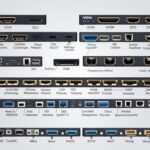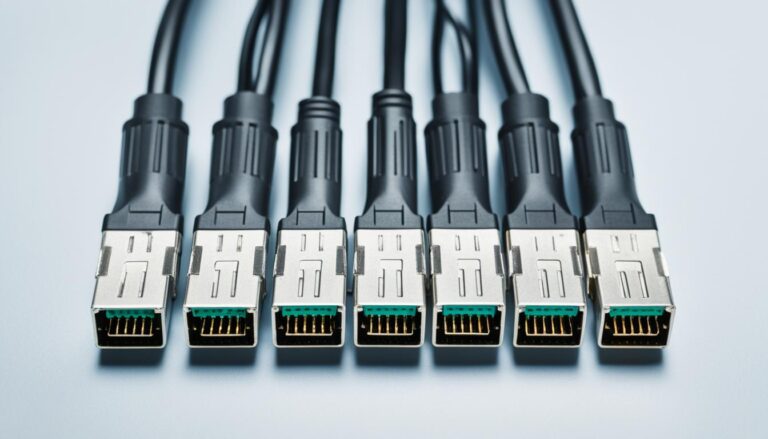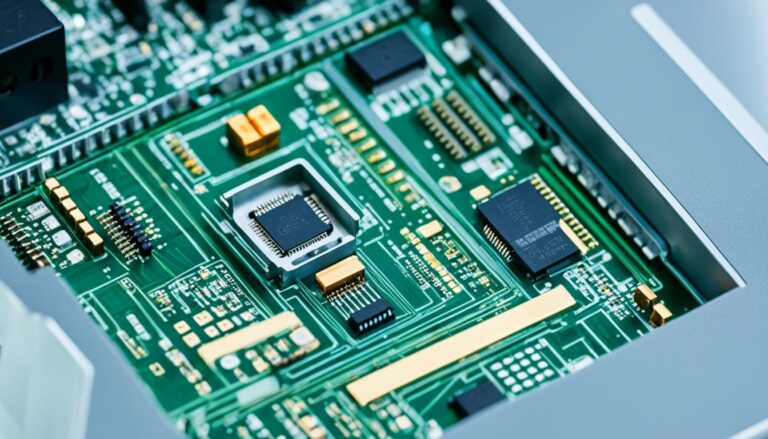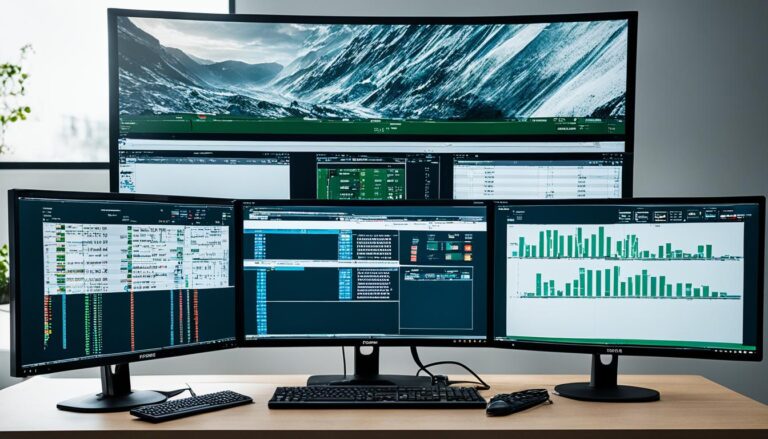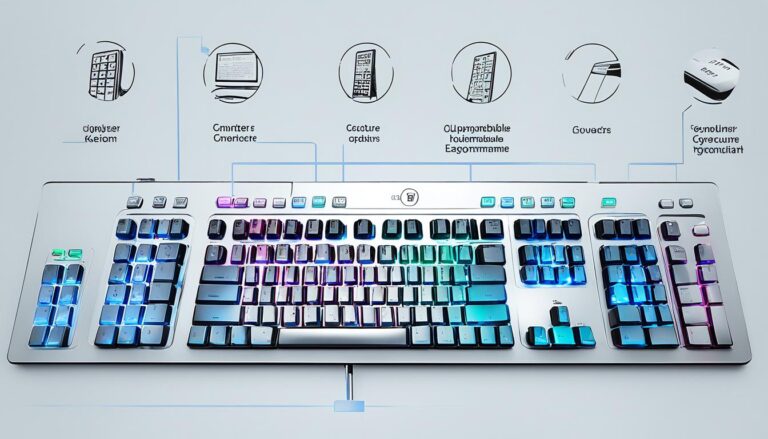Using a monitor with only VGA can seem challenging. But, with the right tips and tricks, you can make the most out of it. VGA, short for Video Graphics Array, is a video connection created by IBM in 1987. It’s older but you can still find VGA ports on many devices like desktops and laptops.
To get the best quality, make sure your computer’s video output matches your monitor’s resolution. VGA and HDMI don’t mix directly, but adapters can bridge the gap. If your monitor has issues, restarting your computer in VGA mode might solve video card problems.
A Brief History of VGA Connections
In 1987, IBM brought out the Video Graphics Array (VGA). It was a game-changer for PC video quality. This system let screens show up to 16 colors at 640×480 resolution. VGA made texts clearer and even small letters stood out more. At first, VGA used analog signals. But as digital tech got more common, converters were made to switch from analog to digital.
The Rise of VGA
VGA answered the call for better graphics on computer screens. With VGA’s launch by IBM, it set new standards. It allowed for more colors and better picture quality, redefining video display tech.
“The Video Graphics Array transformed the way we interact with computer displays, paving the way for more vibrant and detailed visuals.” – Jonathan Morris, Technology Historian
At the start, VGA was mainly for desktop computers, with a VGA port included. Soon, as laptops needed better graphics too, VGA was added to them. This helped VGA become a key interface for displays everywhere.
The Evolution of VGA Connections
Initially, VGA worked on analog signals. But with new tech, digital interfaces like HDMI and DVI came up. So, makers created converters and adapters to link VGA with these new digital techs.
Even today, VGA is important. It works with many devices and is a budget-friendly choice. It helps link old systems to new monitors and projectors.
VGA Connections Timeline
| Year | Event |
|---|---|
| 1987 | IBM introduces Video Graphics Array (VGA) |
| 1999 | VGA to Digital Video Interface (DVI) converters become available |
| 2002 | HDMI-to-VGA adapters allow for easy connection to modern displays |
| 2010 | VGA ports remain standard on desktop and laptop computers |
Despite new display tech, VGA’s impact is still strong. It connects old and new devices, offering backward compatibility. VGA is a trusted choice for many.
Understanding Pixels and VGA Cables
Pixels are tiny dots that create digital graphics on screens and televisions. They make up the images, text, and videos we see. This is how digital visuals are formed.
VGA cables are used to send analog video signals between devices. They have a specific connector design and come in both male and female options. These cables can handle various screen resolutions.
VGA cables are great for video. But, they can’t carry sound. So, you’ll need a different cable for audio when using VGA.
Pixels: The Smallest Units of Visual Display
“Pixels are like tiny pieces that join together. They create the visuals on your screen, like puzzle pieces making a whole picture.”
Pixels are the tiniest bits on a display. Close up, you see individual pixels making up a picture. Each one has a color that adds to the image quality.
The more pixels a screen can show, the better the image. This is what we mean by resolution. It makes pictures much clearer and sharper.
VGA Cables: Enabling Analog Video Transmission
“VGA cables connect devices to send analog video. This gives us great visuals on our screens.”
VGA cables are necessary for linking computers or laptops to compatible screens. They send video signals for clear visuals.
By plugging VGA cables into source and display VGA ports, we get vivid images. This connection is useful for many display screens.
VGA cables have been reliable for years. Even though digital options like HDMI are now more popular, VGA cables are still in use for their video quality.
Comparing VGA Cables and Digital Connections
While VGA cables are traditional, HDMI and other digital connections are becoming more common. Here’s a quick comparison:
| VGA Cables | Digital Connections |
|---|---|
| Transmit analog video signals | Transmit digital video and audio signals |
| Support various resolutions | Provide better image quality and more resolution options |
| Need separate audio cables | Carry both video and audio in one cable |
Digital connections like HDMI have become popular because they send both video and audio. They offer better image quality too.
To get the best display, it’s key to know about pixels and VGA cables. Pixels create what we see, while VGA cables send the video. But now, HDMI and other digital options give us better quality and sound together.
How to Optimize VGA Connections
To get the best picture quality from VGA connections, follow a few simple steps. Start by matching your computer’s video output with your monitor’s native resolution. This prevents the image from stretching or blurring, giving you a clear display. You can change the video resolution in your computer’s display settings.
For laptop users, a special key combo may be needed to send the image to a monitor or TV. This combo usually has an icon of a monitor or says “VGA”. Look in your laptop’s guide or visit the manufacturer’s website to learn how to use the VGA output.
It’s also vital to ensure the computer’s output resolution fits the connected device’s supported resolution. This means the image will fill the screen without losing quality. If connecting a VGA computer to a device without a VGA port, consider a VGA to HDMI adapter. This adapter connects devices with different ports.
In summary, to enhance VGA connections, match resolutions, use key combos as needed, and use adapters for device compatibility. These steps will help you enjoy better image quality through your VGA connection.
Can VGA Work With HDMI?
VGA and HDMI are not directly compatible. VGA sends images through an analog video signal. HDMI, however, is digital and sends both video and audio.
VGA uses a 15-pin connector, while HDMI has a 19-pin connector. You can’t plug VGA directly into HDMI or the other way around.
Still, you can connect VGA to HDMI displays with a converter. This changes VGA’s analog signal to HDMI’s digital signal.
While changing VGA to HDMI is possible, some issues can arise. For instance, not all converters support audio. Also, VGA supports lower resolutions, so image quality might drop with HDMI.
“Although different, VGA and HDMI can work together using the right adapter or converter. This lets you link VGA devices to HDMI screens.”
To clarify, here are the key differences between VGA and HDMI:
| VGA | HDMI |
|---|---|
| Analog video signal | Digital interface |
| Typically supports lower resolutions (e.g., 640×480, 800×600) | Supports high-definition resolutions (e.g., 1920×1080, 3840×2160) |
| 15-pin D-sub connector | 19-pin connector |
| No audio transmission (requires separate audio connections) | Supports both video and audio transmission |
Despite their differences, you can still connect old VGA devices to HDMI screens. Just make sure to pick a good converter.
Summary
In short, VGA and HDMI use different signals. VGA is analog while HDMI is digital. With converters, you can join VGA devices to HDMI screens. Just remember, doing this may affect audio and image quality. Always choose trustworthy converters for a smooth connection between VGA and HDMI.
Troubleshooting VGA Issues
If your monitor isn’t working right, it might be due to a video card problem or old drivers. You may have to start your computer in VGA mode. This mode changes the screen to 640×480 pixels, making it easier to solve issues.
To set up VGA mode, go to the control panel. Look for display settings and then update your drivers. Doing this can fix problems and improve how your monitor works.
Extending Displays with VGA
If you want to have different things on each monitor, don’t use a splitter. It only shows the same thing on both screens. Instead, try a docking station to have different content.
A docking station lets you connect several monitors to your computer. This means you can have different windows open on each one. For instance, you might work on a spreadsheet on one screen and do research on another. This setup helps you do many tasks at once without hassle.
With a docking station, you can use VGA cables to hook up your screens. This is great if your devices only have VGA inputs. The docking station acts as a central point. It lets you plug in other devices like keyboards and USB drives too.
Many docking stations work well with VGA for extended displays. They let you adjust settings like screen size and display angle for each monitor. This way, you can make your work area just right for you.
Benefits of Using a Docking Station for Extended Displays
- Easier multitasking: With independent displays, you can have different applications and documents open on each monitor, making multitasking more efficient and seamless.
- Increased productivity: Extended displays offer a larger workspace, allowing you to view more content simultaneously and work on multiple tasks without constantly switching between windows.
- Better organization: By dedicating specific monitors to different tasks, you can keep your work environment organized and reduce visual clutter.
- Enhanced collaboration: Extended displays are beneficial for collaborative work, as multiple team members can view and work on different aspects of a project simultaneously.
Using a docking station with VGA needs a computer that supports multiple monitors. Make sure your PC and the docking station are compatible.
By using a docking station, you turn your VGA monitors into a versatile and strong work setup.
Conclusion
Working with a monitor that only supports VGA might need some adjustments. But, you can still make it work well. Change the video resolution and use VGA to HDMI adapters to improve the display quality.
Also, restarting in VGA mode can fix video card problems. Using a docking station lets you show different things on each monitor. This makes your setup flexible and helps you get more done.
Whether you’re working, playing games, or watching videos, making VGA connections better matters. Unlock the full power of your VGA-only monitor. Enjoy clear, sharp images and bright colours on your screen.
FAQ
How can I optimize a monitor that only has VGA?
To get the best from a VGA monitor, match your computer’s video resolution with the monitor’s native one. This makes the image clear and sharp. Use adapters to switch VGA to HDMI and back for connecting different devices. Reboot in VGA mode to fix video card problems.
What is the history behind VGA connections?
VGA was launched by IBM in 1987 for PC desktops. It allowed for displaying up to 16 colors at 640×480 resolution. VGA started with analog signals. Over time, it adapted to digital with converters for analog-to-digital conversion.
What are pixels and VGA cables?
Pixels are tiny dots that make up images on screens. VGA cables link devices to show analog video. These cables have 15 pins in three rows and suit many resolutions. But, they don’t carry sound.
How can I optimize VGA connections?
To improve VGA quality, ensure the video resolution matches the monitor’s. This avoids distorted images. On laptops, certain keys help send the image to an external screen. VGA to HDMI adapters are useful if your monitor lacks a VGA port.
Can VGA work with HDMI?
VGA and HDMI differ in signal type and connection. VGA is analog; HDMI is digital. Yet, with a converter or adapter, they can connect. Some transmission types might not work as expected.
How can I troubleshoot VGA issues?
For monitor troubles, such as video card issues or old drivers, try VGA mode restart. VGA mode takes you back to 640×480 resolution to fix problems. Go to the control panel, adjust display settings, and update drivers for better performance.
How can I extend displays with VGA?
Using a splitter won’t extend displays; it just copies the same view. For different content on each screen, get a docking station. It lets you connect several monitors with independent displays.
How can I make the most out of a monitor that only has VGA?
With a VGA-only monitor, set the correct video resolution and use VGA-to-HDMI adapters as needed. Reboot in VGA mode for any fixes. For more screen space, a docking station helps to extend displays. These steps ensure a top-quality viewing experience with a VGA monitor.
